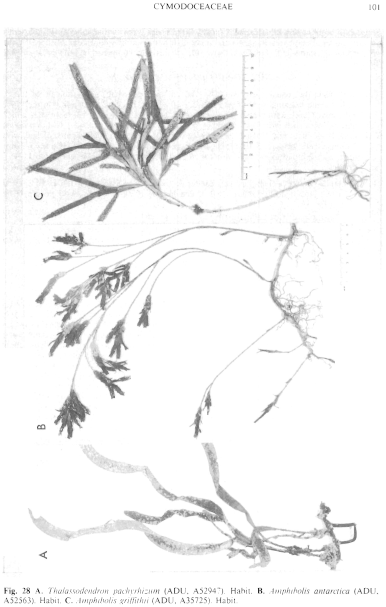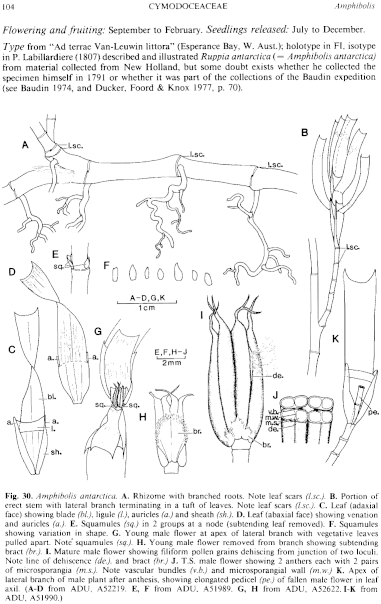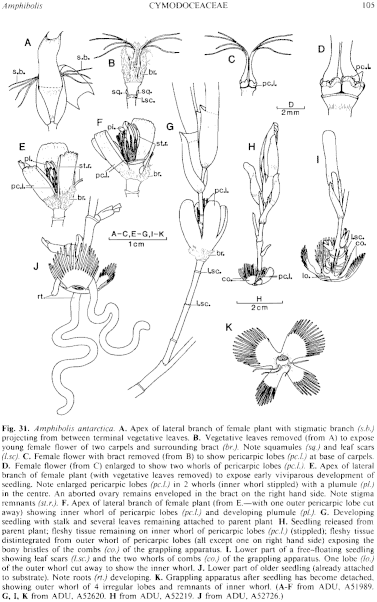|
|
|
|
|
|||||||||||
|
Electronic Flora of South Australia Species Fact Sheet
Phylum Magnoliophyta – Subphylum Seagrasses – Class Liliopsida – Subclass Alismatidae – Order Potamogetonales – Family Cymodoceaceae
Selected citations: Aston 1973: 302, fig. 120. Green 1981: 5. den Hartog 1970: 199, figs 54–56. Jessop 1978: 74, fig. 39.
Synonyms
Ruppia antarctica Labillardière 1807: 116, pl. 264.
Caulinia antarctica (Labillardière) R. Brown 1810: 339. Harvey 1855c: 427.
Cymodocea antarctica (Labillardière) Endlicher 1837: 230. Blackall & Grieve 1954: 8. Ostenfeld 1916: 19. Willis 1970: 68.
Pectinella antarctica (Labillardière) J. Black 1913: 1. PLATE 16 fig. 1;
Dioecious; perennial (Pl. 16 fig. 1, Fig. 28B) with creeping, lignified rhizomes (Fig. 30A) 2–3 (–4) mm thick. Stems erect, much-branched, 1–1.5 mm in diameter, (0.2–) 0.5–1.0 (–1.5) m tall. Roots (Fig. 30A) 1 (rarely 2) at each node, branched, wiry. Leaves (Fig. 30B) in groups of (6–) 8–10, loosely arranged at the ends of branches; sheath (Fig. 30C,D) 6–10 mm long, frequently slightly wider than the blade, margins overlapping at the base only, ligule about 1 mm long, auricles exceeding the ligule, usually about 2 mm long; blade (Fig. 30C,D) 18–30 (–50) mm long, (2–) 3.5–6 (–10) mm broad, L/B 2.5–6 (–10), flat, frequently twisted about 180° in the upper half; apex lunate to truncate, with 2 acute, marginal teeth (absent in juvenile leaves of the seedling). Squamules (Fig. 30E,F) usually 1–3 either side of the stem in the leaf axil, ovate to ovate-lanceolate, about 1 mm long. Male flower (Fig. 30G–J) with a subtending scarious bract; anthers 7–8 (–10) mm long, with 2 or 3 branched appendages each (1–) 2–3 mm long; pedicel (Fig. 30K) elongating to 5–6 mm prior to dehiscence of the anthers. Female flower (Fig. 31A–D) surrounded by a continuous, scarious bract up to 8 mm long, splitting into 2-several laciniate parts; style 4–6 mm long, stigmatic branches 3, about 3 mm long (one or more stigmatic branches may each divide again to form 2 or more secondary branches); pericarpic lobes (Fig. 31C–G) developing in 2 whorls, the outer whorl of 4 unequal lobes (a broad pair and a narrow pair), and the inner whorl of 4 (or more) shorter and narrower lobes, one pair of which is frequently bifid and the other pair trifid. Seedlings (Fig. 31E4) viviparous, development continuing as described for the genus. Seedlings about 6–10 cm long when released, the leaves at first (Fig. 31H) linear, entire, the apex without the 2 acute marginal teeth characteristic of the adult leaf. The comb (Fig. 31H–K), which remains after the disintegration of the fleshy tissue of the pericarp lobes, is 8–10 mm long, with 13–18 bristles in each broad lobe and 7–11 bristles in each narrow lobe.
Type from "Ad terrae Van-Leuwin littora" (Esperance Bay, W. Aust.); holotype in FI, isotype in P. Labillardière (1807) described and illustrated Ruppia antarctica (= Amphibolis antarctica) from material collected from New Holland, but some doubt exists whether he collected the specimen himself in 1791 or whether it was part of the collections of the Baudin expedition (see Baudin 1974, and Ducker, Foord & Knox 1977, p. 70).
Selected specimens: Whitfords Beach, W. Aust., 5 m deep (Lipkin, 2.ii.1982; ADU, A52978). Pondalowie Bay, S. Aust., drift (Robertson, 19.ix.1981; ADU, A52563 and A52620). Pondalowie Bay, S. Aust., 0.5–1 m deep (Johansen, 19.ix.1981; ADU, A52622). Pondalowie Bay, S. Aust., uppermost sublittoral (Robertson, 14.xi.1981; ADU, A52726). Groper Bay, near Pondalowie Bay, S. Aust., uppermost sublittoral (Robertson, 14.xi.1981; ADU, A52570). Aldinga Beach, S. Aust., drift (Gordon-Mills, 5.vii.1981; ADU, A52219). Victor Harbor, S. Aust., 0–3 m deep (Clarke & Engler, 7.xi.1981; ADU, A51989 9 and A51990 8). Kelso, Tamar Estuary, Tas., drift (H. Robertson, 5.xii.1982; ADU, A53902).
Distribution: From Carnarvon, W. Aust. around the southern Australian coast to Wilsons Promontory in Victoria, Bass Strait islands and the northern coast of Tasmania. It grows in sandy mud bottoms, or as patches on flat rock under conditions of moderate to fairly strong water movement, from the uppermost sublittoral zone to 23 m deep. Amphibolis antarctica is frequently an early coloniser in denuded areas in Posidonia australis meadows (Cambridge 1975, p. 157).
Taxonomic notes: Intergrades between A. antarctica and A. griffithii are rare but some deep water (20 and 23 m) specimens from Investigator Strait, S. Aust. (Watson, 7.i.1971; ADU, A38428 and 9.i.1971; ADU, A38434) exhibit some characters intermediate between these two species.
When A. antarctica male flowers are shed, the shoreline adjacent to a large Amphibolis meadow may be strewn with many thousands of yellow-green empty anthers.
References:
ASCHERSON, P. (1867b). Vorarbeiten zu einer Uebersicht der phanerogamen Meergewächse. Litinaea 35, 152–208.
ASTON, H. (1973). Aquatic plants of Australia. (Melbourne University Press: Melbourne.)
BAUDIN, N. (1974). Journal of Nicolas Baudin. Translated from the French by C. Cornell. (Libraries Board of S. Aust.: Adelaide.)
BLACK, J.M. (1913). The flowering and fruiting of Pectinella antarctica (Cymodocea antarctica). Trans. R. Soc. S. Aust. 37, 1–5, 1 Plate.
BLACKALL, W.E. & GRIEVE, B.J. (1954). How to know Western Australian Wildflowers. Part I. (University of Western Australia Press: Perth.)
BROWN, R. (1810). Prodromus Florae Novae Hollandiae et Insulae Van-Diemen. (Taylor: London.)
CAMBRIDGE, M.L. (1975). Seagrasses of south-western Australia with special reference to the ecology of Posidonia australis Hook. f. in a polluted environment. Aquat. Bot. 1, 149–161.
DEN HARTOG, C. (1970). The seagrasses of the World. Verh. k. ned. Akad. Wet. Afd. Natuurk., ser. 2, 59(1), 1–275 (-1–31 Plates).
DUCKER, S.C., FOORD, N.J. & KNOX, R.B. (1977). Biology of Australian Seagrasses: the genus Amphibolis C. Agardh (Cymodoceaceae). Aust. J. Bot. 25, 67–95.
ENDLICHER, S.L. (1837). Genera Plantarum secundum ordines naturalis disposita. Publ. 1836–1840. (Beck: Vienna.)
GREEN, J.W. (1981). Census of the Vascular Plants of Western Australia. (Western Australian Herbarium: South Perth.)
HARVEY, W.H. (1855c). Some Account of the marine botany of the colony of Western Australia. Trans. R. Ir. Acad. 22, 525–566.
JESSOP, J.P. (1978). J.M. Black's Flora of South Australia. 3rd edn. Part I. (Govt. Printer: Adelaide.)
OSTENFELD, C.H. (1916). Contributions to West Australian Botany. I. The Seagrasses of West Australia. Dansk. bot. Arkiv. 2(6), 1–44.
WILLIS, J.H. (1970). A handbook to plants in Victoria. Vol. 1. 2nd edn. (Melbourne University Press: Melbourne.)
The Marine Benthic Flora of Southern Australia Part I complete list of references.
Publication:
Womersley, H.B.S. (31 May, 1984)
The Marine Benthic Flora of Southern Australia
Part I
©Board of the Botanic Gardens and State Herbarium, Government of South Australia
Illustrations in Womersley Part I, 1984: FIGS 28B, 30, 31.

Figure 28 enlarge
Fig. 28 A. Thalassodendron pachyrhizum (ADU, A52947). Habit. B. Amphibolis antarctica (ADU, A52563). Habit. C. Amphibolis griffithii (ADU, A35725). Habit.

Figure 30 enlarge
Fig. 30. Amphibolis antarctica. A. Rhizome with branched roots. Note leaf scars (/.sc.). B. Portion of erect stem with lateral branch terminating in a tuft of leaves. Note leaf scars (l.sc.). C. Leaf (adaxial face) showing blade (bl.), ligule (l.), auricles (a.) and sheath (sh.). D. Leaf (abaxial face) showing venation and auricles (a.). E. Squamules (sq.) in 2 groups at a node (subtending leaf removed). F. Squamules showing variation in shape. G. Young male flower at apex of lateral branch with vegetative leaves pulled apart. Note squamules (sq.). H. Young male flower removed from branch showing subtending bract (br.). I. Mature male flower showing filiform pollen grains dehiscing from junction of two loculi. Note line of dehiscence (de.). and bract (br.) J. T.S. male flower showing 2 anthers each with 2 pairs of microsporangia (m.s.). Note vascular bundles (v.b.) and microsporangial wall (m.w.) K. Apex of lateral branch of male plant after anthesis, showing elongated pedicel (pe.) of fallen male flower in leaf axil. (A–D from ADU, A52219. E, F from ADU, A51989. G, H from ADU, A52622. I–K from ADU, A51990.)

Figure 31 enlarge
Fig. 31. Amphibolis antarctica. A. Apex of lateral branch of female plant with stigmatic branch (s.b.) projecting from between terminal vegetative leaves. B. Vegetative leaves removed (from A) to expose young female flower of two camels and surrounding bract (br.). Note squamules (sq.) and leaf scars (1.sc). C. Female flower with bract removed (from B) to show pericarpic lobes (pc.l.) at base of carpels. D. Female flower (from C) enlarged to show two whorls of pericarpic lobes (pc.l.). E. Apex of lateral branch of female plant (with vegetative leaves removed) to expose early viviparous development of seedling. Note enlarged pericarpic lobes (pc.l.) in 2 whorls (inner whorl stippled) with a plumule (pl.) in the centre. An aborted ovary remains enveloped in the bract on the right hand side. Note stigma remnants (st.r.). F. Apex of lateral branch of female plant (from E.-with one outer pericarpic lobe cut away) showing inner whorl of pericarpic lobes (pc.l.) and developing plumule (pl.). G. Developing seedling with stalk and several leaves remaining attached to parent plant H. Seedling released from parent plant; fleshy tissue remaining on inner whorl of pericarpic lobes (pc.l.) (stippled); fleshy tissue distintegrated from outer whorl of pericarpic lobes (all except one on right hand side) exposing the bony bristles of the combs (co.) of the grappling apparatus. I. Lower part of a free-floating seedling showing leaf scars (l.sc.) and the two whorls of combs (co.) of the grappling apparatus. One lobe (lo.) of the outer whorl cut away to show the inner whorl. J. Lower part of older seedling (already attached to substrate). Note roots (rt.) developing. K. Grappling apparatus after seedling has become detached, showing outer whorl of 4 irregular lobes and remnants of inner whorl. (A–F from ADU, A51989. G, I,K from ADU, A52620. H from ADU, A52219. J from ADU, A52726.)

|
Email Contact: State Herbarium of South Australia |

|